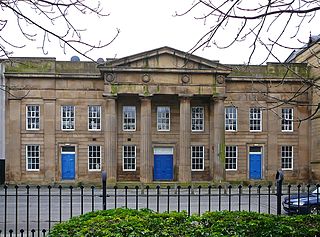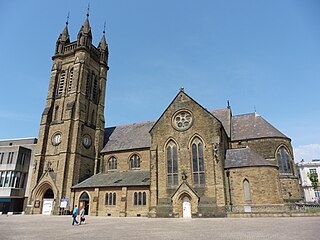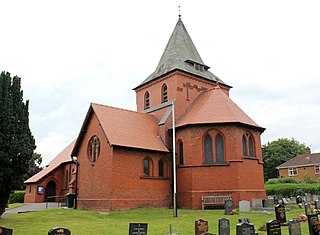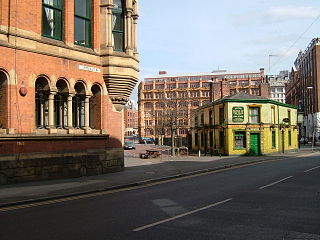
Chorlton-cum-Hardy is a suburban area of Manchester, in Greater Manchester, England, three miles (4.8 km) southwest of the city centre. Chorlton ward had a population of 14,138 at the 2011 census, and Chorlton Park 15,147.

Chorlton-on-Medlock is an inner city area of Manchester, in the county of Greater Manchester, England.

Hulme is an inner city area and electoral ward of Manchester, in Greater Manchester, England, immediately south of Manchester city centre. It has a significant industrial heritage.

Whalley Range is an area of Manchester, England; it is located about 2 miles (3.2 km) south-west of the city centre. The population at the 2011 census was 15,430. Historically in Lancashire, it was one of the earliest of the city's suburbs, built by local businessman Samuel Brooks.
St. Clement's Church, St. Clement Church or variants may refer to:

The Church of St Mary the Virgin is in the village of Bowdon near Altrincham, Greater Manchester, England. It is recorded in the National Heritage List for England as a designated Grade II* listed building. It is an active Anglican parish church in the diocese of Chester, the archdeaconry of Macclesfield and the deanery of Bowdon.

Barlow Moor is an area of Manchester, England. It was originally an area of moorland between Didsbury and Chorlton-cum-Hardy and was named after the Barlow family of Barlow Hall. Barlow Moor Road runs through the area and connects to Wilmslow Road at the southern end and Manchester Road at the northern end. Southern Cemetery and Chorlton Park are landmarks on the route. Immediately adjacent to the northwest corner of the cemetery, also on Barlow Moor Road, is the Manchester Crematorium which opened in 1892, the second in the United Kingdom. The architects were Steinthal and Solomons who chose to revive the Lombard-Romanesque style. Another notable building is the Chorlton Park Apartments, 2002.

The Parish Church of St Mary the Virgin is a Church of England parish church in Leigh, Greater Manchester, England. It is a member of the Salford & Leigh deanery in the archdeaconry of Salford, diocese of Manchester. It is recorded in the National Heritage List for England as a designated Grade II* listed building.

St Stephen and All Martyrs' Church, Lever Bridge, is in Darcy Lever, Bolton, Greater Manchester, England. It is an active Anglican parish church in the deanery of Walmsley, the archdeaconry of Bolton, and the diocese of Manchester. The church is recorded in the National Heritage List for England as a designated Grade II* listed building, and is the first of three "pot churches" designed by Edmund Sharpe, so-called because they are constructed largely of terracotta.

Holy Trinity Platt Church, is in Platt Fields Park in Rusholme, Manchester, England. It is an active Anglican parish church in the deanery of Hulme, the archdeaconry of Manchester, and the diocese of Manchester. The church is recorded in the National Heritage List for England as a designated Grade II* listed building. It is the second "pot church" designed by Edmund Sharpe, so-called because the main building material used in the construction of the church is terracotta.

The parish church of Blackpool Saint John the Evangelist, or St John's Blackpool, is an Anglican church in Blackpool, Lancashire, England. It was completed in 1878 and is a Grade II listed building. A church was built on the site in 1821 and was replaced by the current building to accommodate a larger congregation. The church was designed by Garlick, Park and Sykes in the Early English style and has been restored and renovated in 1986 and from 2000 to 2006. St John's is known as the parish church of Blackpool, and is an active parish church in the Diocese of Blackburn which is within the ecclesiastical province of York. It is in the Archdeaconry of Lancaster and the Deanery of Blackpool.

St James, Didsbury, on Stenner Lane, is a Grade II* Church of England church in the Manchester suburb of Didsbury and with Emmanuel church is part of the parish of St James and Emmanuel, Didsbury.

St Maxentius' Church is in Bradshaw, Bolton, Greater Manchester, England. It is an active Anglican parish church in the deanery of Walmsley, the archdeaconry of Bolton and the diocese of Manchester. Its benefice is united with those of five other local churches. Standing separately from the church is the tower of an earlier church. The present church is dedicated to Saint Maxentius, an obscure French saint, and is the only church in England with this dedication.

All Saints Church, Great Saughall, is located in Church Road in the civil parish of Saughall and Shotwick Park, formerly Saughall and before that Great Saughall, in the county of Cheshire, England. It is an active Anglican parish church in the deanery of Wirral South, the archdeaconry of Chester, and the diocese of Chester. The church is recorded in the National Heritage List for England as a designated Grade II listed building.

All Saints Church is in Delph Lane, Barnacre-with-Bonds, Lancashire, England. It is an active Anglican parish church in the deanery of Garstang, the archdeaconry of Lancaster, and the diocese of Blackburn. Its benefice is united with those of St Peter, Scorton, and St John the Evangelist, Calder Vale. The church is recorded in the National Heritage List for England as a designated Grade II listed building.

St Leonard's Church is in the village of Balderstone, Lancashire, England. It is an active Anglican parish church in the deanery of Whalley, the archdeaconry of Blackburn, and the diocese of Blackburn. The church is recorded in the National Heritage List for England as a designated Grade II listed building.
Manley Hall was a large house in Whalley Range, Manchester. It was a two-storey Victorian Italianate building with fifty rooms, very grandly furnished and with a fine art collection. It stood in 80 acres (32 ha) of exotic gardens with artificial lakes and many greenhouses in which orchids were grown.

Sam Mendel (1811–1884), the "Merchant Prince", was one of the leading merchants in Manchester during its rise to industrial prominence. He was born in Liverpool, but the family soon relocated to Manchester where his father, Emmanuel, established a rope, twine, and pitch-paper business and then later a hotel, the Manchester and Liverpool. Samuel first worked in a warehouse on Bow Street belonging to Mr. B. Liebert, and during this time he also travelled extensively. Building on his experience he began his own business and rapidly became one of Manchester's leading textile merchants. He built a large warehouse, Chepstow House, in central Manchester.



















